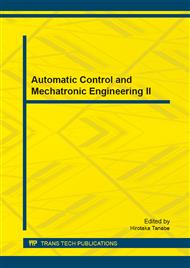[1]
J. Ward and J. Peppard: Reconciling the IT/business relationship: A troubled marriage in need of guidance, Journal of Strategic Information Systems, 5(1996), p.37–65.
DOI: 10.1016/s0963-8687(96)80022-9
Google Scholar
[2]
N. G. Carr. IT doesn't matter. Harvard Business Review, 5(2003), p.41–49.
Google Scholar
[3]
M. Wade and J. Hulland: Review: MIS Quarterly, 28(2004), p.107–142.
Google Scholar
[4]
A. S. Bharadwaj: MIS Quarterly, 24(2000), p.169–196.
Google Scholar
[5]
S. Ward: Information professionals for the next millennium, Journal of Information Science, 25 (1999) , p.239– 247.
Google Scholar
[6]
D. Yong. International Journal of Advanced Manufacturing Technology, 28(2006), p.839–844.
Google Scholar
[7]
I. Seol and J. Sarkis, Managerial Auditing Journal, 20(2005), p.876–892.
Google Scholar
[8]
M. Saremi, S. F. Mousavi and A. Sanayei, Expert Systems with Applications, 36(2009), p.2742–2749.
DOI: 10.1016/j.eswa.2008.01.034
Google Scholar
[9]
L.S. Chen and C.H. Cheng, European Journal of Operational Research, 160(2005), p.803–820.
Google Scholar
[10]
C. T. Chen, Fuzzy Sets and Systems, 114 (2000), p.1–9.
Google Scholar
[11]
Z. Gungora, G. Serhadliog˘lub and S.E. Kesen, Applied Soft Computing, 9(2009), p.641–646.
Google Scholar
[12]
Alecos Kelemenis and Dimitrios Askounis: Expert Systems with Applications, (2009), doi: 10. 1016/j. eswa. 2009. 12. 013.
Google Scholar
[13]
L. Canos and V. Liern, European Journal of Operational Research, 189(2008), p.669–681.
Google Scholar
[14]
C.F. Chien and L.F. Chen, Expert Systems with Applications, 34(2008), p.280–290.
Google Scholar
[15]
E. Jereb, U. Rajkovic and V. Rajkovic, International Journal of Selection and Assessment, 13(2005), p.198–205.
DOI: 10.1111/j.1468-2389.2005.00315.x
Google Scholar
[16]
C.T. Chen C.T. Lin and S.F. Huang, International Journal of Production Economics, 102(2006), p.289–301.
Google Scholar
[17]
Mansour Momeni, Mahammad Reza Fathi, Mahammad Karimi Zarchi and Sirous Azizollahi, Middle-East Journal of Scientific Research, 8(2011), pp.699-706.
Google Scholar
[18]
C.L. Hwang and K. Yoon, Multiple Attributes Decision Making Methods and Applications, Berlin, Heidelberg: Springer. (1981).
Google Scholar
[19]
T.L. Saaty: The Analytic Hierarchy Process, McGraw-Hill, NewYork, (1980).
Google Scholar
[20]
P. Wang and et al. A fuzzy model for selection of QoS-aware web services in IEEE International Conference on e-Business Engineering, ICEBE 2006, October 24-26 Oct 2006. Shanghai, China: Inst. of Elec. and Elec. Eng. Computer Society.
DOI: 10.1109/icebe.2006.3
Google Scholar
[21]
Ting-Ya Hsieh, Shih-Tong Lu, Gwo-Hshiung Tzeng, International Journal of Project Management 22 (2004) p.573–584.
Google Scholar
[22]
Debmallya Chatterjee and Dr. Bani Mukherjee, International Journal of Engineering Science and Technology, 2(2010), 2499-2510.
Google Scholar
[23]
C. Kahraman, S. Çevik, N. Y. Ates, & M. Gülbay, Computers and Industrial Engineering, 52(2007), p.414–433.
DOI: 10.1016/j.cie.2007.01.005
Google Scholar
[24]
Alvydas Balezentis, Tomas Balezentis, Willem K.M. Brauers, INFORMATICA, 23(2012), p.173–190.
Google Scholar


